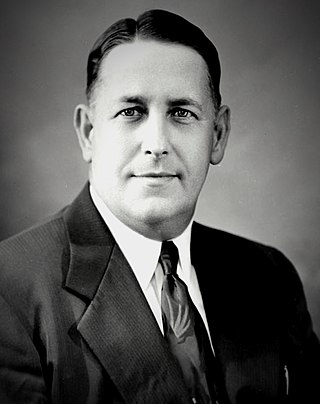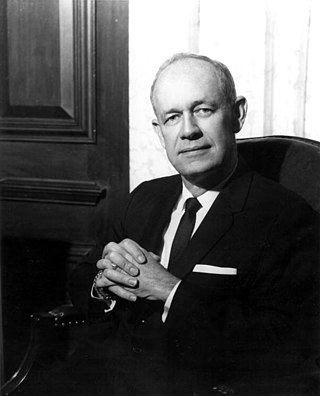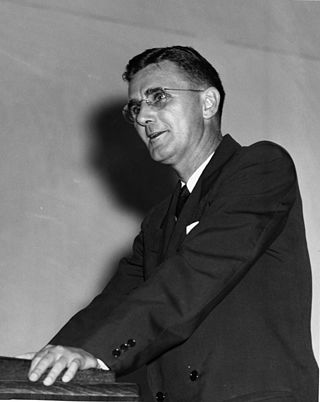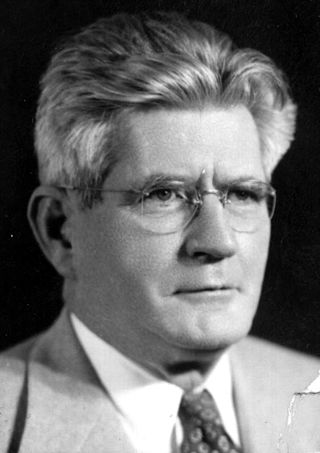
Jefferson County is a county located in the Big Bend region in the northern part of the U.S. state of Florida. As of the 2020 census, the population was 14,510. Its county seat is Monticello.

Charles William Young was an American politician who served in the United States House of Representatives from 1971 until his death in 2013. A Republican from Florida, Young served as chairman of the House Committee on Appropriations from 1999 to 2005. He was the longest-serving Republican member of Congress at the time of his death.

Charley Eugene Johns was an American politician. Johns served as the 32nd Governor of Florida from 1953 to 1955.

Cecil Farris Bryant was an American politician serving as the 34th governor of Florida. He also served on the United States National Security Council as director of the Office of Emergency Planning during the administration of President Lyndon B. Johnson, who also appointed Bryant chair of the U.S. Advisory Commission on Intergovernmental Relations.

Edward Gresham Ball was a businessman who wielded powerful political influence in Florida for decades. Referred to as "a law unto himself", despite the fact that he never held public office and did not own much of the assets he controlled, he led a forest products company, a railroad and owned newspapers. He worked for and with his brother-in-law Alfred I. du Pont for nine years before running the Alfred I. duPont Testamentary Trust's businesses himself for another 46 years. He founded and led the St. Joe Paper Company to become a major player in several industries in Florida. He was a leader of the anti-communist Pork Chop Gang, a group of Democratic Party legislators from North Florida.

The Constitution of the State of Florida is the document that establishes and describes the powers, duties, structure, and function of the government of the U.S. state of Florida, and establishes the basic law of the state. The current Constitution of Florida was ratified on November 5, 1968.

Homosexuality and Citizenship in Florida, also known as the Purple Pamphlet, was an anti-homosexual propaganda pamphlet published in January 1964 by the Florida Legislative Investigation Committee (FLIC) of the Florida Legislature led by State Senator Charley Johns. The booklet contained several pornographic images and a glossary of terminology used in the gay community. It was sold for 25 cents a copy, with a discount for bulk orders of 100 copies or more.

The Aucilla River rises in Brooks County, Georgia, USA, close to Thomasville, and passes through the Big Bend region of Florida, emptying into the Gulf of Mexico at Apalachee Bay. Some early maps called it the Ocilla River. It is 89 miles (143 km) long and has a drainage basin of 747 square miles (1,930 km2). Tributaries include the Little Aucilla and Wacissa Rivers. In Florida, the Aucilla River forms the eastern border of Jefferson County, separating it from Madison County on the northern part, and from Taylor County to the south.

Batchoy, alternatively spelled batsoy, is a Filipino noodle soup of pork offal, crushed pork cracklings, chicken stock, beef loin and round noodles. The popular variant, the La Paz Batchoy, traces its roots to the district of La Paz, Iloilo City in the Philippines.

The Florida Legislative Investigation Committee was established by the Florida Legislature in 1956, during the era of the Second Red Scare and the Lavender Scare. Like the more famous anti-Communist investigative committees of the McCarthy period in the United States Congress, the Florida committee undertook a wide-ranging investigation of allegedly subversive activities by academics, Civil Rights Movement groups, especially the NAACP, and suspected communist organizations.

Julius Wayne Reitz was an American agricultural economist, professor and university president. Reitz was a native of Kansas, and earned bachelor's, master's and doctorate degrees in his chosen field. After working as an agricultural economist, university professor and U.S. government agricultural administrator, Reitz was selected to be the fifth president of the University of Florida, serving from 1955 until 1967.

Doak Sheridan Campbell was from 1941 to 1957 president of Florida State College for Women and its successor coeducational school, Florida State University. He oversaw the creation of this new university. His opposition to the admission of African-American students has caused controversy about the naming of Doak S. Campbell Stadium in his honor.
Rodney W. "Rod" Hamilton is a Minnesota politician and former member of the Minnesota House of Representatives. A member of the Republican Party of Minnesota, he represented District 22B, which includes all or portions of Cottonwood, Jackson, Nobles and Redwood counties in the southwestern part of the state. He is also a local pork producer.
Robin K. Brown is a Minnesota politician and a former member of the Minnesota House of Representatives (2007-2011) A member of the Minnesota Democratic-Farmer-Labor Party (DFL), she represented District 27A, which includes all or portions of Freeborn and Mower counties in the southeastern part of the state.
The Stanley Plan was a package of 13 statutes adopted in September 1956 by the U.S. state of Virginia. The statutes were designed to ensure racial segregation would continue in that state's public schools despite the unanimous ruling of the U.S. Supreme Court in Brown v. Board of Education (1954) that school segregation was unconstitutional. The legislative program was named for Governor Thomas B. Stanley, a Democrat, who proposed the program and successfully pushed for its enactment. The Stanley plan was a critical element in the policy of "massive resistance" to the Brown ruling advocated by U.S. Senator Harry F. Byrd Sr. The plan also included measures designed to curb the Virginia state chapter of the National Association for the Advancement of Colored People (NAACP), which many Virginia segregationists believed was responsible for "stirring up" litigation to integrate the public schools.
Thomas Brown Manuel, was a Florida community leader, politician, and state official, often referred to as the "Father of the Florida's Turnpike" for his efforts to bring about the first major highway in Florida, and for his contributions generally to economic development in the state.
Ronald (Ron) Edward Kraus is a Minnesota politician and was a member of the Minnesota House of Representatives from 1995 to 1999. Kraus, a Republican, who represented District 27A, which included all of Freeborn county in the southeastern part of the state.
A pork chop is a cut of pig meat.

Raeburn C. Horne was a politician in the state of Florida. He served in the Florida House of Representatives in 1931 and 1957, as a Democrat, representing Madison County.
Ruth Willis Perry was an American librarian, journalist, and civil rights activist. She is known for her work with the Miami chapter of the NAACP and her stand against the Johns Committee, also known as the Florida Legislative Investigation Committee, which investigated alleged subversive actions by the NAACP.















